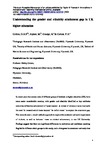Understanding the gender and ethnicity attainment gap in UK higher education
| dc.contributor.author | Cotton, Debby | |
| dc.contributor.author | Joyner, M | |
| dc.contributor.author | George, R | |
| dc.contributor.author | Cotton, Peter | |
| dc.date.accessioned | 2015-01-29T11:08:46Z | |
| dc.date.accessioned | 2015-01-29T11:09:10Z | |
| dc.date.available | 2015-01-29T11:08:46Z | |
| dc.date.available | 2015-01-29T11:09:10Z | |
| dc.date.issued | 2015-01-29 | |
| dc.identifier.issn | 1470-3297 | |
| dc.identifier.issn | 1470-3300 | |
| dc.identifier.uri | http://hdl.handle.net/10026.1/3216 | |
| dc.description.abstract |
In recent years the success rates of different groups of students in higher education (HE), have come under considerable scrutiny, with gender and ethnicity identified as key attributes predicting differential achievement of ‘good degrees’. A review of previous studies highlights the need for research which looks beyond ‘the deficit model’ to explain the attainment gap. This research used a mixed-methods approach to explore the academic and social experiences of students, as well as lecturers’ views on student achievement, in one UK University. Findings suggest that there are significant differences in motivation and confidence speaking English for different ethnic groups in this study, and a divergence in attendance and study time by gender – both of which may go some way to helping understand the gaps in attainment. In addition, male and BME students tended to over-estimate their likelihood of achieving a good degree outcome, compared to other groups. | |
| dc.format.extent | 475-486 | |
| dc.language | en | |
| dc.language.iso | en | |
| dc.publisher | Informa UK Limited | |
| dc.relation.replaces | http://hdl.handle.net/10026.1/3215 | |
| dc.relation.replaces | 10026.1/3215 | |
| dc.subject | Gender | |
| dc.subject | Ethnicity | |
| dc.subject | Diversity | |
| dc.subject | Inclusivity | |
| dc.subject | Attainment | |
| dc.title | Understanding the gender and ethnicity attainment gap in UK higher education | |
| dc.type | journal-article | |
| dc.type | Article | |
| plymouth.author-url | http://dx.doi.org/10.1080/14703297.2015.1013145 | |
| plymouth.issue | 5 | |
| plymouth.volume | 53 | |
| plymouth.publication-status | Accepted | |
| plymouth.journal | Innovations in Education and Teaching International | |
| dc.identifier.doi | 10.1080/14703297.2015.1013145 | |
| plymouth.organisational-group | /Plymouth | |
| plymouth.organisational-group | /Plymouth/Faculty of Health | |
| plymouth.organisational-group | /Plymouth/Faculty of Science and Engineering | |
| plymouth.organisational-group | /Plymouth/Faculty of Science and Engineering/School of Biological and Marine Sciences | |
| plymouth.organisational-group | /Plymouth/PS - Student Services | |
| plymouth.organisational-group | /Plymouth/REF 2021 Researchers by UoA | |
| plymouth.organisational-group | /Plymouth/REF 2021 Researchers by UoA/UoA06 Agriculture, Veterinary and Food Science | |
| plymouth.organisational-group | /Plymouth/Research Groups | |
| plymouth.organisational-group | /Plymouth/Research Groups/Marine Institute | |
| plymouth.organisational-group | /Plymouth/Users by role | |
| plymouth.organisational-group | /Plymouth/Users by role/Academics | |
| dc.identifier.eissn | 1470-3300 | |
| dc.rights.embargoperiod | Not known | |
| rioxxterms.versionofrecord | 10.1080/14703297.2015.1013145 | |
| rioxxterms.licenseref.uri | http://www.rioxx.net/licenses/all-rights-reserved | |
| rioxxterms.type | Journal Article/Review |


